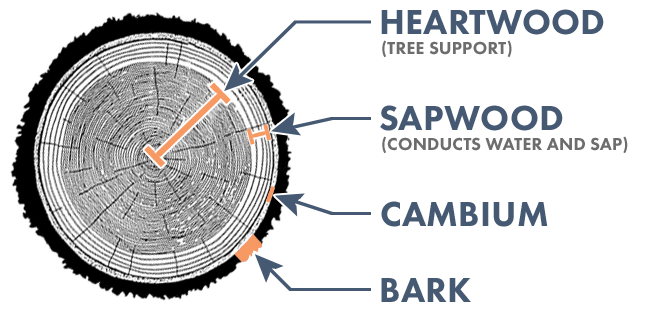CONVENTIONAL PRUNING
There are many kind of pruning which vary according to the specific need of the tree or the owners requirements:
01
Hazard pruning:
consists in removing dead or ill branches, cutting the stubs¹, removing branches rubbing together (wearing and tearing of the bark).
02
Thinning:
completed by removing 15 to 30% of the leafy mass (branches and leaves as a whole) which minimizes potential breaking by offering less hold to wind and ice storm. This thinning also allows more light to make its way through to the ground, resulting in a better balance between shade and sun exposure.
03
Crown raising:
raising the crown of a tree is instrumental in increasing indirect light under it. It is done by removing low branches from the trunk and shortening branches growing towards the ground, all around the boughs. It is important not to cut big branches to the trunk; large wounds almost never heal and allow decay to make holes in the trunk, thus weakening the structure of the tree over time.
04
Clearance pruning:
Mostly used to satisfy the owner’s needs or those of a complaining neighbour by clearing infrastructures neighbouring the tree: house, clothes-line, wire, etc.
05
Topping:
Cutting the top of a tree is to be adopted as a last resort. We rarely use it and especially in very definite circumstances when all other avenues have been explored, for it reduce the life expectancy of the tree. On the other hand, topping is used for some fruit-trees.
FELLING AND PRUNING NEAR ELECTRICAL NETWORKS
We have teams trained and authorized by Hydro-Québec to fell and prune trees located near electrical networks. Each team includes a works manager (RDT) who establishes, with the operators of the Hydro-Québec operation and distribution center (CED), protection on the power lines near which the trees to be treated are located, in order to carry out the work with maximum safety. This work is done either under restraint (power cut without resetting in the event of an accident), either with physical protection on the wires (orange conductor covers) or with a planned power off (MHT).
ELECTRICAL NETWORK PRUNING:
Pruning consisting in clearing the electrical networks interfering with vegetation. This clearing is paramount to ensure continuity of service, particularly during periods of strong winds or ice storm *.
We agree upon that network pruning is not of perfect aestheticism. It’s the ‘policy of choosing for the lesser of two evils’ for which we came to after years of experiments in collaboration with arborists, forest engineers, local intervenients and vegetation control specialists at Hydro-Québec. In return, every cut is done according to the acknowledged rules and principles of the ‘sap-drawer’².
This clearance pruning doesn’t affect in anyway the survival of the trees. It is done this way almost everywhere in the world. (See burying wires ³).
Network pruning has to be done by arborists authorised by Hydro-Quebec because most of the time they work close to a ‘live’ electric network of 14 400 or 25 000 volts!
* Don’t take any chance. When in doubt, contact Hydro-Quebec.
FELLING
Consist in removing a tree in the most secure way possible. Felling a tree is often the last solution, when pruning cannot resolve the problems. It is the case with dead trees where the felling has to be performed in the following months for when the tree is too dry and risky for an arborist to climb it, we have to use cranes to dismantle it (when not accessible to the aerial bucket truck), multiplying costs of operation.
The felling of a tree may be required for other reasons: sick tree (to prevent propagation of incurable diseases), hazardous tree (trunk decay), construction, selective felling (too many trees in the same area), etc.
The use of cranes is sometimes needed.
For most municipalities, a permit is required to cut down a more than 10 cm diameter tree (measured at chest height).
STUMP REMOVAL
Mechanically allows the removal of the visible part of the stump (trunk and the visible surface roots). The device used for this purpose has a rotating wheel with carbide teeth that grinds the stump under the ground level. The roots left underground rot naturally after a while.
A space of 91cm (36 inches) is necessary to allow passage for our smaller stump grinder device (ex.: gate of a fence).
TO GUY WIRE TREES
In some cases the guying line makes it possible to secure forks by installing textile cables braided between the branches to allow the tree to withstand the weather. These cables called Cobra are provided with a sheath which surrounds the trunk of the branches to be secured without injuring them. They also have a rubber core inside the braiding of the fabrics which allows a stretchability of the shroud during strong winds making it even more efficient. However, the shrouds have certain disadvantages which may have worse consequences than the intended benefits. For example a guyed branchwhich breaks by gale can sometimes lead in its fall another branch with which it is connected. We really use the guy ropes as a last resort when all the other solutions have been exhausted.
LEXICON
01
¹Stubs:
The sap-drawer principle consists in always doing the cuts right after a secondary stem. It allows the sap to be drawn to the cut and the bottom of the stem so it doesn’t dry. It also prevents a strong stimulation for the tree in growing new stems where the cut has been done.
02
²Sap-drawer:
The principle of the sap call is to always make cuts above a secondary stem. This allows the sap to be attracted to the end of the cuts and to avoid on the one hand the formation of dead wood, and on the other hand, the excessive stimulation of new regrowths.
03
³Burying wires:




